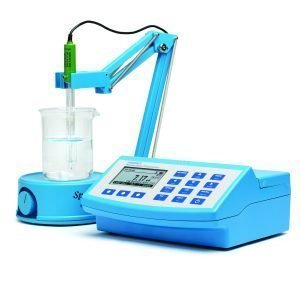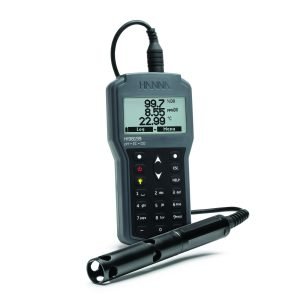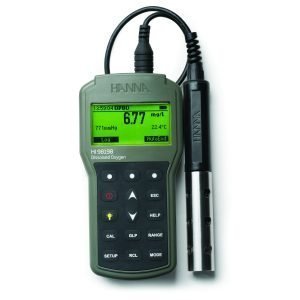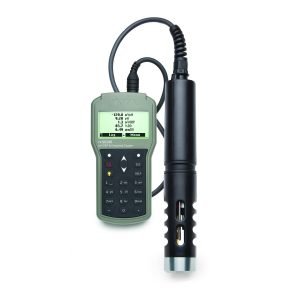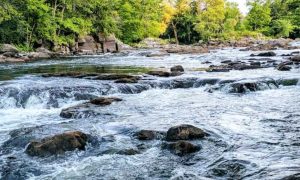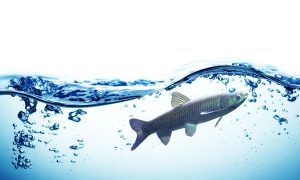Fish farming or pisciculture implies cultivation of fish for commercially use, in tanks or enclosures such as fish ponds, usually for food. This is the principal form of aquaculture, while some other methods are considered mariculture.
The world needs for source of proteins are increasing, and fish are often included in their diet as a source of lean proteins. Human needs for fish effect on many fisheries, special locations for harvesting fish. Many od those locations are being depleted faster than the populations can recover and that problem is called overfishing. Prices of fish on the market are constantly rising and sustainability is worrying and ongrowing problem in the world. Many manufacturers are turning to aquaculture for farm-raised fish. Fish raised that way provide a steady supply of sustainable fish without stressing natural fisheries.
Aquaculture implies underwater farming. Many species can be cultivated through aquaculture, such as shellfish, fish, and even aquatic plants. Trout and catfish are popular species of fish to farm due to the simplicity of cultivation.
The world needs for source of proteins are increasing, and fish are often included in their diet as a source of lean proteins. Human needs for fish effect on many fisheries, special locations for harvesting fish. Many od those locations are being depleted faster than the populations can recover and that problem is called overfishing. Prices of fish on the market are constantly rising and sustainability is worrying and ongrowing problem in the world. Many manufacturers are turning to aquaculture for farm-raised fish. Fish raised that way provide a steady supply of sustainable fish without stressing natural fisheries.
Aquaculture implies underwater farming. Many species can be cultivated through aquaculture, such as shellfish, fish, and even aquatic plants. Trout and catfish are popular species of fish to farm due to the simplicity of cultivation.
MONITORING WATER QUALITY IN FISH FARMING
The core of successful fish farming definitely is water quality. Water is an environment where fish grow, live, breathe and eat. Eventually, because of their metabolism, they will excrete waste in that water. The biggest waste products from fish is ammonia (NH3) because it is highly toxic to fish. Concentration as little as 0,02 mg/L shows a toxic aspect on fish, depending on the species. It is relieving that some of the ammonia is ionized to ammonium (NH4+) when it enters the water. pH determines how much ammonia will become ionized. If the pH decreases, the amount of ammonium will increase. Ammonium is more desirable than ammonia, because ammonium is less toxic to fish. Consequently, aquaculturists must measure both the pH and ammonia levels. That helps them to determine how much remains as ammonia, and how much is ionized to the less harmful ammonium. Total ammonia levels should be kept below 3 ppm in tank water. Usage of microorganisms that metabolize ammonia to nitrates can lower the levels of ammonia. This process is known as nitrification.
Ammonium and ammonia can be measured with the Nessler method in which the reagents react with ammonia and ammonium to create a yellowbrown compound. If the concentration of ammonium and ammonia is higher, the intensity of the color will be higher. Photometers can be used to measure the intesity of the color because human eyes can not detect subtle color changes.
APPLICATION
For our clients it is important to have an instrument that can preform reliably and accurately with every measure. Hanna Instruments have the best solution for those kind of measures and it can help aquaculturist with their fish-farming.
HI83303 is a compact, multiparameter photometer for use in aquaculture applications. The meter is one of the most advanced photometers available with an innovative optical design that utilizes a reference detector and focusing lens to eliminate errors from changes in the light source and from imperfections in the glass cuvette. This meter has 20 different programmed methods measuring 12 key water quality parameters and also offers an absorbance measurement mode for performance verification and for users that would like to develop their own concentration versus absorbance curves.
Aquaculture parameters include alkalinity, calcium, nitrite, and phosphate which are critical to maintaining a healthy system. It also contains parameters specific to either a marine or freshwater environment. You can also measure dissolved oxygen, ammonia, calcium, free chlorine, total chlorine, copper, nitarte which are important parameters for aquaculture.
To save valuable laboratory benchtop space, the HI83303 doubles as a professional pH meter with its digital pH/temperature electrode input. Now one meter can be used for both photometric and pH measurements.
pH MEASURE OF WATER
Since fish live in water throughout their life cycle, it is necessary to constantly measure the pH. pH values greater than 9,5 and values less than 4,5 are not good for the life cycle of many organisms in water. If the pH value is 4 or lower it comes to acid death. When the pH value is somewhere between 4 to 5 there will be no reproductive cycle in fish. Slow growth can occur if the pH value is between 4 to 6,5. Desirable ranges for fish reproduction is from pH 6,5 to pH 9. If the pH value is between 9 to 10 slow growth of fishes will occur. pH value higher than 11 it comes to alkaline death.
For measuring pH you can use pH electrode from HI83303 or you can use Multiparameter Portable pH/EC/DO Waterproof Meter – HI98199.
The HI98199 is a rugged, portable multiparameter meter with a single digital probe input. The digital probe input allows the connection of either a pH, conductivity or dissolved oxygen probe. Between the three probes and a built-in barometric pressure transducer the HI98199 can measure up to 10 water quality parameters with 5 being measured by sensors and the other 5 by calculation (i.e. EC to TDS). This professional, waterproof meter complies to IP67 standards and is supplied with all necessary accessories to measure pH/temperature packaged into a durable carrying case.
IMPORTANCE OF DISSOLVED OXYGEN
Dissloved oxygen refers to the level of free, non-compound oxygen present in water or other liquids. This parameter tells us about water quality because of its influence on the organisms living within a body of water. Non-compound oxygen, or free oxygen (O2), is oxygen that is not bonded to any other element. Presence of free O2 molecules within water is actualy dissolved oxygen. If the oxygen molecules are bonded in water (H2O), that does not count toward dissolved oxygen levels.
The level of dissolved oxygen (DO) is one of the most critical paramaters in water quality and fish farming. DO is incorporated into the water from atmospheric air and photosynthesis from phytoplanktons. To have healthy fish, oxygen levels of 60 to 70% saturation is needed. If the DO levels are to low that will affect fish and their growth. Fish that seem lethargic and are more on the surface ot the water, face the problem of lack of oxygen. Sometimes they lose appetite and they growth can be affected. Bigger fish need more oxygen and if there isn’t enough oxygen they will develope symptoms sooner. Because all of that dissolved oxygen should be measured daily.
Source: https://www.fondriest.com/environmental-measurements/parameters/water-quality/dissolved-oxygen/
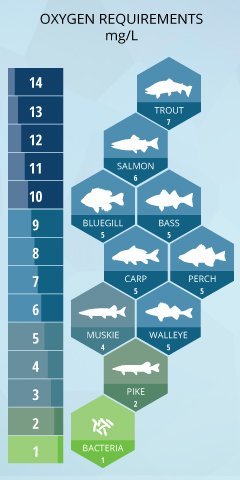
How can we measure dissolved oxygen?
Benchtop meters
Portable meters
Process control
In addition to the already mentioned HI98199, Optical Dissolved Oxygen Meter HI98198 can also be used to measure dissolved oxygen.
The HI98198 obdo™ meter is rugged, portable dedicated dissolved oxygen (DO) meter designed for fresh and saltwater measurements of DO. This porfessional, waterproof meter complies with IP67 standards and measure DO, barometric pressure, and temperature. The HI98198 is supplied with a HI764113 digital optical DO probe in a custom thermoformed durable carrying case with accessorise. It is compact and ergonomically designed to provide ready access to the materials required for routine sampling.
FACILITATED MEASUREMENT OF MULTIPLE PARAMETERS USING HANNA INSTRUMENTS MULTIPARAMATER DEVICES
Multiparameter pH/ORP/DO/Pressure/Temperature Waterproof Meter – HI98196
the HI98196 is a waterproof portable logging multiparameter meter that monitors up to 7 different water quality parameters including 5 measured and 2 calculated. The microprocessor based multi-sensor probe allows for the measurement of key parameters including pH, ORP, dissolved oxygen, and temperature. The probe transmits readings digitally to the meter, where data points can be displayed and logged. The use of digital communication allows for noise free transfer of data for up to 100 meters in cable length. The complete system is simple to setup and easy to use.
Multiparameter pH/ORP/EC/TDS/Salinity/DO/Pressure/ Temperature Waterproof Meter – HI98194
The HI98194 is a waterproof portable logging multiparameter meter that monitors up to 12 different water quality parameters including 6 measured and 6 calculated. The microprocessor based multi-sensor probe allows for the measurement of key parameters including pH, ORP, conductivity, dissolved oxygen, and temperature. The probe transmits readings digitally to the meter, where data points can be displayed and logged. The HI98194 is supplied with all necessary accessories and packaged in a durable carrying case.
Portable pH/EC/DO Meter with Bluetooth – HI98494
Functional and accurate, this meter is capable of testing 12 different water quality parameters using pH, EC, and optical DO sensors. Transfer data to a smart device for review or sharing with the integrated Bluetooth connection and Hanna Lab App. Device is waterproof ( meter rated IP67, probe rated IP68). It has automatic interval logging of up to 45,000 samples or log-on-demand. HI98494 is perfect for environmental and industrial professionals.
HI9829 Multiparameter pH/ISE/EC/DO/Turbidity Waterproof Meter with GPS option
The HI9829 is a waterproof portable logging multiparameter meter that monitors up to 14 different water quality parameters. The microprocessor based multi-sensor probe allows for the measurement of key parameters including pH, ORP, conductivity, dissolved oxygen, turbidity, ammonium, chloride, nitrate, and temperature. The probe transmits readings digitally with options to log data while disconnected from the meter. An optional GPS provides location tracking of measurements. The complete system is simple to setup and easy to use. The HI9829 is highly customizable and supplied with all necessary accessories, packaged in a durable carrying case.
Two probes to choose from (Basic or Logging)
The HI7609829 (basic) and HI7629829 (logging) are multiparameter probes for use with the HI9829 portable meter. It is an option to choose which probe will be supplied with the HI9829. By default the HI9829 and corresponding probe will be supplied with a pH/ORP, conductivity and dissolved oxygen sensors. Either probe can be upgraded to measure turbidity with a turbidity/conductivity sensor.
FISHFARM AUTOMATION
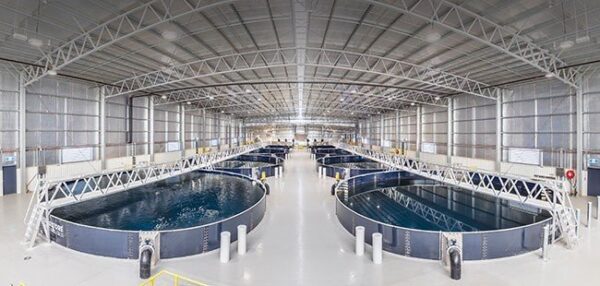
If you want to completely upgrade your production, we can project control system for your fish farm dealing with intensive fish culture. The automation system is used for monitoring and control of environmental parameters (like pH, D.O., temperature), fish feeding, aeration. It offers an easier approach to the maintenance, especially in the field of scheduled tasks to be performed daily by technical staff. It provides continuous monitoring of D.O. levels and possibility of alarm settings. D.O. controlling & monitoring equipment is often used in conjunction with aerators, in this way minimizing the D.O. drift affected pond downtime.
Oxygen content of the pond water can be influenced by two methods; by change of flow rate, and by aeration of pond water.
This is one of the ways that fish farm can be optimized in order to maximize its economic profit.
All of our equipment can be connected online, giving the users the commotion of connecting remotely.
Authors:
Nives Vinceković Budor, dipl.kem.ing.
Tajana Frančić, mag.nutr.

